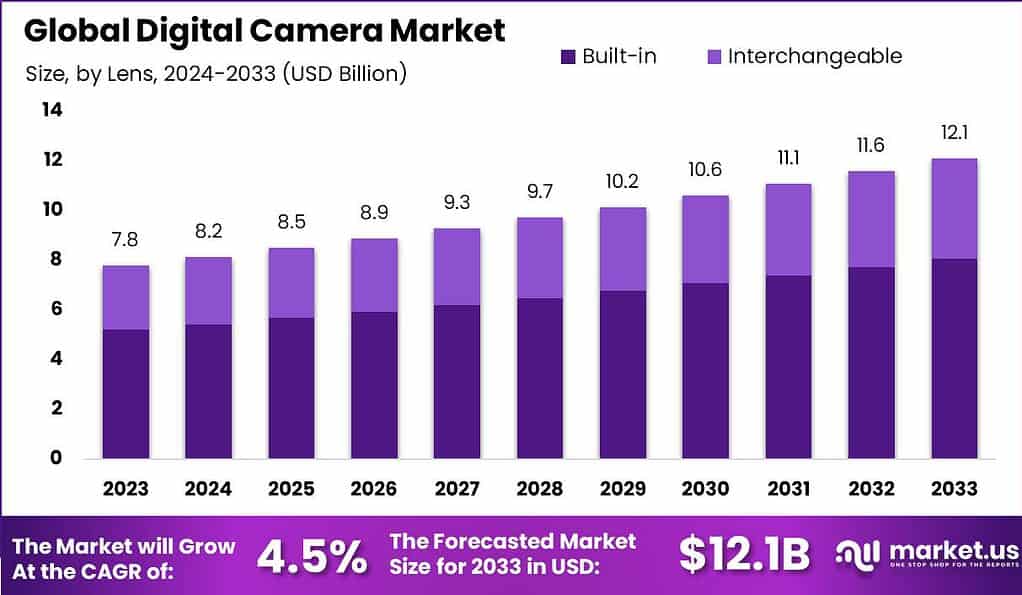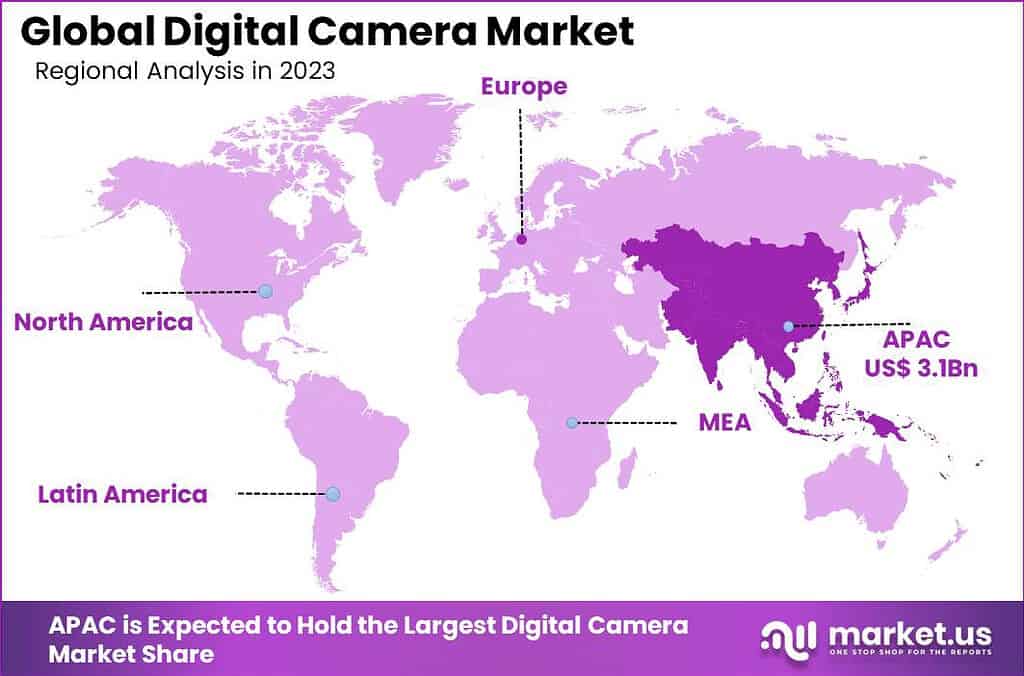Table of Contents
Digital Camera Market Size
In 2023, the Global Digital Camera Market was valued at USD 7.8 billion, with a projected CAGR of 4.5% expected to drive the market to approximately USD 12.1 billion by 2033. This growth is supported by rising consumer interest in high-resolution imaging, content creation trends, and advanced photographic capabilities.
The digital camera market stands as a dynamic and evolving segment within consumer electronics, shaped by advancing technologies and ever-changing user preferences. Individuals and professionals continue to seek better image quality, creative control, and versatility, making digital cameras a preferred choice for capturing visual content in numerous applications.
The market caters to a wide array of users, ranging from photography enthusiasts to businesses who utilize digital cameras in marketing, advertising, film, and surveillance. The influence of social media and content platforms has further accelerated users’ interest in crafting high-quality and engaging visual stories.

One major driving factor is the rapid innovation in imaging technologies. Breakthroughs in sensor quality, image processing, autofocus, and stabilization have allowed manufacturers to deliver more sophisticated cameras every year. Another factor propelling demand is the growing culture of digital content creation. People worldwide want to document their lives and share professional-level photos and videos, especially as social media influence expands.
The demand for digital cameras remains robust among both professionals and serious hobbyists. Unlike smartphones, which serve casual users, digital cameras deliver superior image clarity and manual control that content creators and photographers value. A growing segment of users include vloggers, influencers, and content producers seeking high-end video capabilities, exceptional low-light performance, and interchangeable lens systems.
Digital Camera Statistics
- The global digital camera market showed steady growth. In 2023, it was valued at USD 7.8 billion and is expected to reach USD 12.1 billion by 2033. This reflects a CAGR of 4.5% from 2024 to 2033.
- Asia-Pacific led the market in 2023. It generated USD 3.1 billion, holding over 40.2% of the global share. Strong demand in Japan, China, and South Korea supported this growth.
- The built-in lens segment dominated in 2023. It accounted for 66.7% of the total share. These cameras are popular for their simplicity and portability.
- Mirrorless cameras captured more than 48% of the market in 2023. They are lighter and faster than DSLRs. Users prefer them for travel and professional use.
- Professional photographers remained a key user base. In 2023, they continued to drive demand for high-quality cameras. This group values performance, precision, and reliability.
APAC Digital Camera Market Size
The Asia-Pacific (APAC) region led the global market in 2023, securing a 40.2% share and generating USD 3.1 billion in revenue. This leadership is underpinned by the presence of prominent camera manufacturers, a high concentration of technology-savvy consumers, and growing demand for mirrorless and DSLR cameras in countries like Japan, China, and South Korea. Additionally, increasing disposable income and the expansion of social media platforms have accelerated the need for high-quality visual content, making APAC a pivotal region for digital imaging innovations.

Emerging Trend
The Mirrorless Camera Revolution
One of the most impactful trends in the digital camera world is the surge in popularity of mirrorless cameras over traditional DSLR models. Mirrorless designs feature a slimmer, more compact body and deliver advanced features like speedy autofocus and robust image stabilization.
Take advantage of our unbeatable offer - buy now!

Photographers at every skill level appreciate how these cameras combine portability with professional-grade performance. The rush to innovate in this segment reflects how manufacturers are prioritizing lightweight options packed with smart technology, meeting the demand for both convenience and creative control in today’s fast-moving digital landscape.
Market Driver
Demand for Creative Control and High-Quality Imagery
High-quality images are no longer just for professionals. Everyday consumers are becoming more interested in capturing moments with stunning clarity, thanks in part to the constant sharing of photos online.
The desire for creative flexibility – such as manual settings and interchangeable lenses- continues to encourage people to invest in digital cameras, especially those who want more control than what is offered by smartphones. The rise of social content creators, hobbyists, and enthusiasts further fuels this momentum, as these groups look for equipment that delivers a unique edge in image and video quality.
Restraint
Smartphone Competition Shakes the Traditional Camera Market
Despite technical advancements, digital cameras face a serious obstacle from the rapid evolution of smartphone cameras. Today’s smartphones come equipped with sophisticated photographic technology that can easily satisfy the average user’s daily needs.
Because smartphones are always on hand, multifunctional, and deliver good photos instantly, many people opt not to purchase a separate digital camera. This shift means traditional cameras are losing ground in the entry-level and point-and-shoot segments, making it tough for established brands to maintain their previous levels of demand.
Opportunity
Integration of AI and Advanced Features
There’s exciting potential for digital cameras as they integrate artificial intelligence and other advanced technologies into their systems. By adding smart features like real-time scene recognition, automated settings, and AI-assisted image editing, camera makers can appeal to a wider audience – especially tech enthusiasts and creative professionals.
With AI, even beginners can enjoy high-quality photography, while more experienced users can achieve artistic results with greater ease. This intersection of smart technology and imaging creates a valuable pathway for growth, as it enables products to stand out and serve users looking for intuitive, high-performing tools.
Market Challenge
Balancing Innovation with High Production Costs
Digital camera companies are under pressure to release products that include the latest in sensor technology, connectivity options, and processing power. However, developing and manufacturing these innovations is expensive, and the uncertainty of global supply chains can make costs even harder to predict.
As a result, it’s a challenge to keep new models affordable and readily available, especially when profit margins are thin and competition is fierce. This ongoing struggle to balance innovation with sustainability and operational efficiency is a hurdle that manufacturers must carefully navigate to remain relevant in the market.
Key Market Segments
Lens Type
- Built-in
- Interchangeable
Product Type
- Compact Digital Camera
- DSLR
- Mirrorless
End Use
- Pro Photographers
- Prosumers
- Hobbyists
Top Key Players in the Market
- Canon Inc.
- Eastman Kodak Company
- FUJIFILM Holdings Corporation
- Leica Camera AG
- Nikon Corporation
- Olympus Corporation
- OM Digital Solutions Corporation
- Panasonic Corporation
- Comp9RICOH IMAGING COMPANY, LTD.
- SIGMA CORPORATION
- Sony Corporation
- Hasselblad
Report Scope
| Report Features | Description |
|---|---|
| Market Value (2023) | USD 7.8 billion |
| Forecast Revenue (2033) | USD 12.1 Billion |
| CAGR (2024-2033) | 4.5% |
| Base Year for Estimation | 2023 |
| Historic Period | 2019-2022 |
| Forecast Period | 2023-2033 |
| Report Coverage | Revenue Forecast, Market Dynamics, COVID-19 Impact, Competitive Landscape, Recent Developments |
| Segments Covered | By Lens (Built-in, Interchangeable), By Product (Compact Digital Camera, DSLR, Mirrorless), By End-use (Pro Photographers, Prosumers, Hobbyists) |
| Regional Analysis | North America (US, Canada), Europe (Germany, UK, Spain, Austria, Rest of Europe), Asia-Pacific (China, Japan, South Korea, India, Australia, Thailand, Rest of Asia-Pacific), Latin America (Brazil), Middle East & Africa(South Africa, Saudi Arabia, United Arab Emirates) |
Explore More Reports
- AI Note Taking Market
- Flexible Display Market
- Smart Stadium Market
- Light Weapons Market
- IT Outsourcing Market
- AI In Beauty and Cosmetics Market
Discuss your needs with our analyst
Please share your requirements with more details so our analyst can check if they can solve your problem(s)



